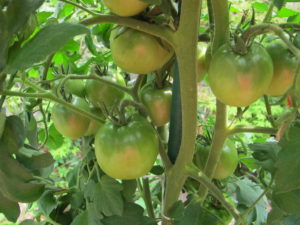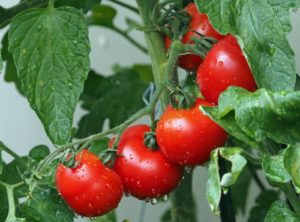Page 2
Sun Scald
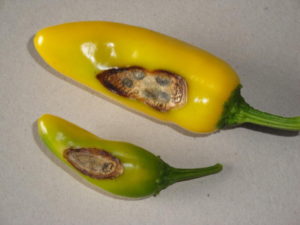
‘Lemon Dream’ sweet peppers with sun scald.
Pepper stems should not be thinned. Because the fruits are easily scalded by the sun on hot summer days, good foliage cover is a necessity. Sun scald occurs on the area of the fruit that is perpendicular to the hottest rays of the sun. It looks like a gray or brown blistered, and then dried, patch of skin.
You don’t have to throw it away. Just cut out the bad part and enjoy the rest of it. Reposition the leaves to protect the other fruits. If that doesn’t work, loosely cover the plant on especially hot days. Use cheesecloth, an old sheer curtain, or knitted shade cloth (not landscape fabric) supported on bamboo stakes. Apply fertilizer, especially one with high nitrogen content, to stimulate foliage growth on pepper plants lacking vigor. After the plant forms a leafy canopy, switch back to fertilizers appropriate for this crop.
Tomato fruits, on the other hand, often start rotting with sun scald. Again, providing foliage cover prevents this problem.
Blossom End Rot: Tomatoes and Peppers
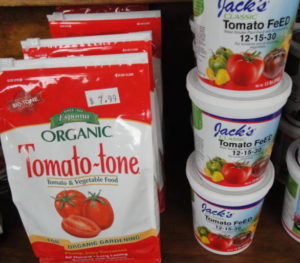
Tomato-tone and Tomato Feed.
Because our plants have been in the ground for a month, I recently applied a soluble fertilizer. This product, Tomato Feed, contains everything the tomatoes need to bulk up their foliage and to prepare them for flowering.
In 3 weeks, I’ll use an organic granular fertilizer that has a high calcium content (8%), such as Tomato-tone. By then, the first fruits will have begun developing.

Blossom end rot on ‘Black Prince’ tomato, mid May, 2019.
Blossom end rot is characterized by a black, sunken, rotting area on the fruit where the blossom used to be attached. It occurs when there is not enough calcium and soil moisture present at the same time. Rapidly growing tomatoes need a constant supply of soluble calcium; without it, cells begin collapsing. It occurs at the point farthest from the roots.
BER sometimes occurs even with adequate supplies of moisture and calcium. During very humid or dry weather, or where there’s no air movement around the plant, transpiration slows down. Stomata, or stomates, are tiny pores on the leaf surface that allow gas exchange between the atmosphere and the interior of the leaf. In very dry, hot, or windy weather, stomates close to conserve moisture.
Although stomates are open in humid weather, transpiration slows down due to lack of “pull” from the atmosphere. When transpirational pull decreases, less dissolved calcium flows through the plant from the roots to the fruits. Avoid planting tomatoes in a corner, where the air is still.
(***Update***: The fruit in the photograph, above, was squeezed between the stem and the stake, as you can see by the indentation. This limited the flow of moisture and nutrients to that fruit. I believe this constriction caused BER, as no other fruits have the problem. The next fertilizer application was with Tomato-tone. 6/7/2019)
Watering Tomatoes
During this lovely, warm, breezy weather, I’ve been watering the young plants every other day. We haven’t had a good rain in weeks! A transplant with a limited root system needs frequent watering until the roots expand.
Watering encourages the plants to grow fast and healthy, and prevents wilt. A wilted plant is a stressed plant, and, if it happens repeatedly, the plant will remain stunted. It also is more susceptible to attack from insect pests and diseases. And, of course, the harvest will be disappointing.
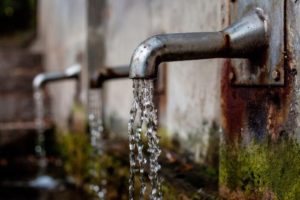
During this early phase, foliage and roots grow vigorously. Later, when the roots have ventured widely, I will ease up on the watering. Then the plants will enter the flowering phase.
When flowers are getting pollinated and little fruits can be seen, the garden will get enough water to keep the plants growing. But I don’t want to encourage lush foliage growth at the expense of flower production. Providing too much water as the fruits approach harvest dilutes the flavor, so water only if necessary.
Well established vegetable plants in loamy soil need about 1½” of water per week. Now that their roots are growing out beyond the drip line of the plants, the entire garden bed will need a thorough watering every week. Occasional heavy rainstorms certainly contribute, but passing showers don’t add enough water. Fast-draining sandy soils, gardens near trees, heavily planted beds, and gardens without mulch might need water twice a week. If the weather is especially hot, dry, or breezy, you might have to water every 2 or 3 days.
Resist the temptation to give them a little water every day. This encourages the roots to grow close to the surface of the soil. Lower roots can die from drought.
Potted Tomatoes
Gardeners without garden space can easily grow tomatoes in large pots for the growing season. I use containers that measure at least 20″ in diameter for indeterminate varieties. These plants, though, require daily attention in hot weather. Mature, leafy tomatoes on the deck need water every day or two.
During hot weather, you might have noticed that tomato plants stop setting fruit. This happens because the pollen dies above a certain temperature particular for each variety. Your local cooperative extension service can recommend varieties appropriate for your region.
Going away for a few days or longer presents a challenge, especially to gardeners growing vegetables in containers. A drip irrigation system is worth considering, or trade services with a neighbor.
Measuring the Water
Whether it’s in the form of rain or from the end of the hose, it’s often difficult to judge exactly how much water the garden is getting. You could set out a few straight-sided containers (like coffee cans) or rain gauges to measure the amount of water the garden is receiving from the sky or from a sprinkler.
Loamy garden soil will feel moist about 5-6″ into the soil after applying 1″ of water. The same amount moistens only 4″ of heavy clay soil, which holds more water between the tiny particles. But the water spreads over a wider area of clay. The moisture profile in sandy soil will be a deep and narrow cone.
Dig up a shovelful of soil a few hours after watering to check moisture distribution if you’re in doubt.
If you installed soaker hoses or drip irrigation tubes, it’s a good idea to check the soil periodically by digging up a sample. Do the plants at the end of the line look a little droopy even though the rest look okay? Sometimes the emitters become detached or soil might clog the line, and sometimes a wayward shovel is to blame.
You can schedule watering automatically with a special timer attached to the faucet. Adjust the settings if the soil seems wet or too dry. In established gardens, watering deeply but infrequently is preferable to watering shallowly and frequently.
Water early in the day so the foliage is dry going into the evening. Always, always, keep the leaves of your vegetables and herbs as dry as possible.
Deer
Did I mention that deer are fond of tomato and pepper foliage? Sturdy permanent fencing gives the best protection. Or use tall stakes and create a teepee or a barrier around the plant, and drape with deer netting. Because the tomato grows fast, check the netting daily and adjust it before the plant becomes hopelessly entangled. Also, check to see if any animals might have gotten stuck in the netting.
Swish some water in an empty milk container before recycling it. Then throw the diluted milk solution on and around the tomato plant. Deer dislike the fats in dairy products. Sometimes, this is enough to deter the deer until more secure solutions are in place.
They’re Weeds, After All!
You might want to start with disease resistant varieties as your main crops, and maybe an heirloom, such as ‘Cherokee Purple’. Proper staking, watering, pruning, and fertilizing will reward you with delicious and abundant harvests.
Left alone, these weedy plants, native to Central and South America, will produce tomatoes. But, by paying attention to certain issues, the plants will maintain good health longer into the season. Once heavy frost kills the summer crops, you’ll have other opportunities for growing cool season greens and vegetables for the next few months. That’s something to look forward to!
Headings
Page 1: How Are the Tomatoes Doing?, And Peppers?, Determinate Or Indeterminate Tomatoes, Staking, Young Plants, Suckers (How Many Main Stems?, Can I Root Those Suckers?), and Limb It Up
Page 2: Sun Scald, Blossom End Rot: Tomatoes and Peppers, Watering Tomatoes, Deer, and They’re Weeds, After All!
